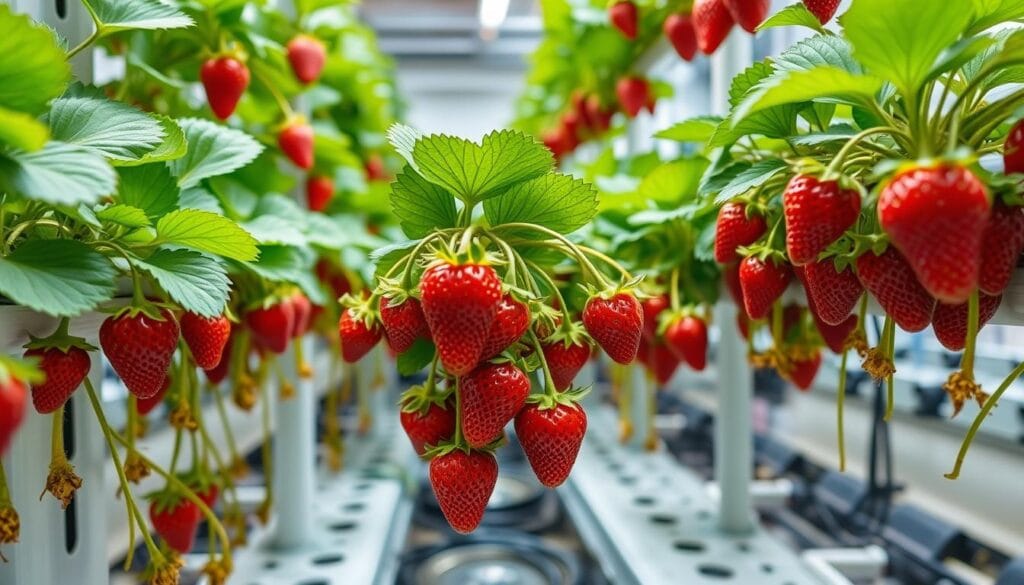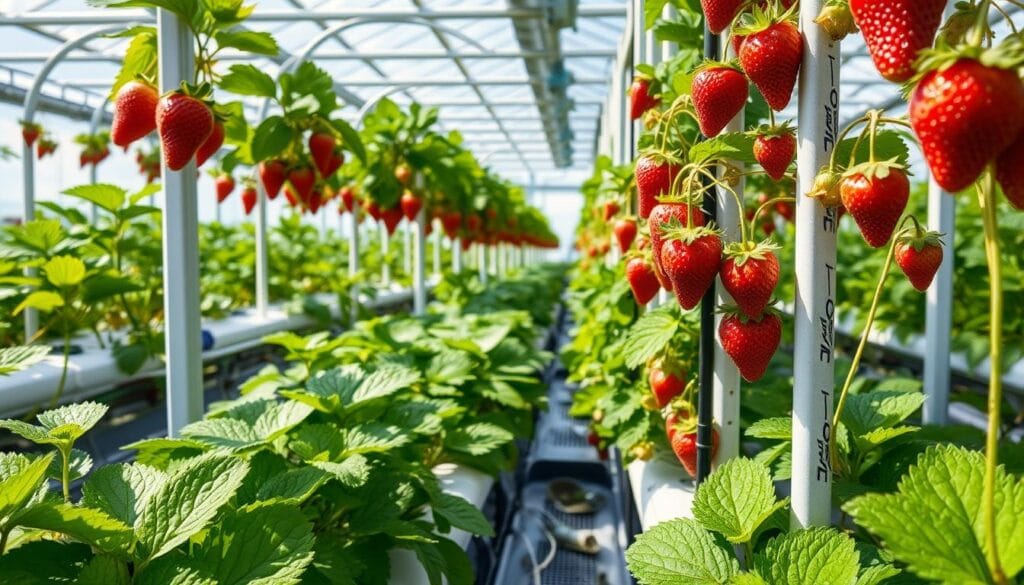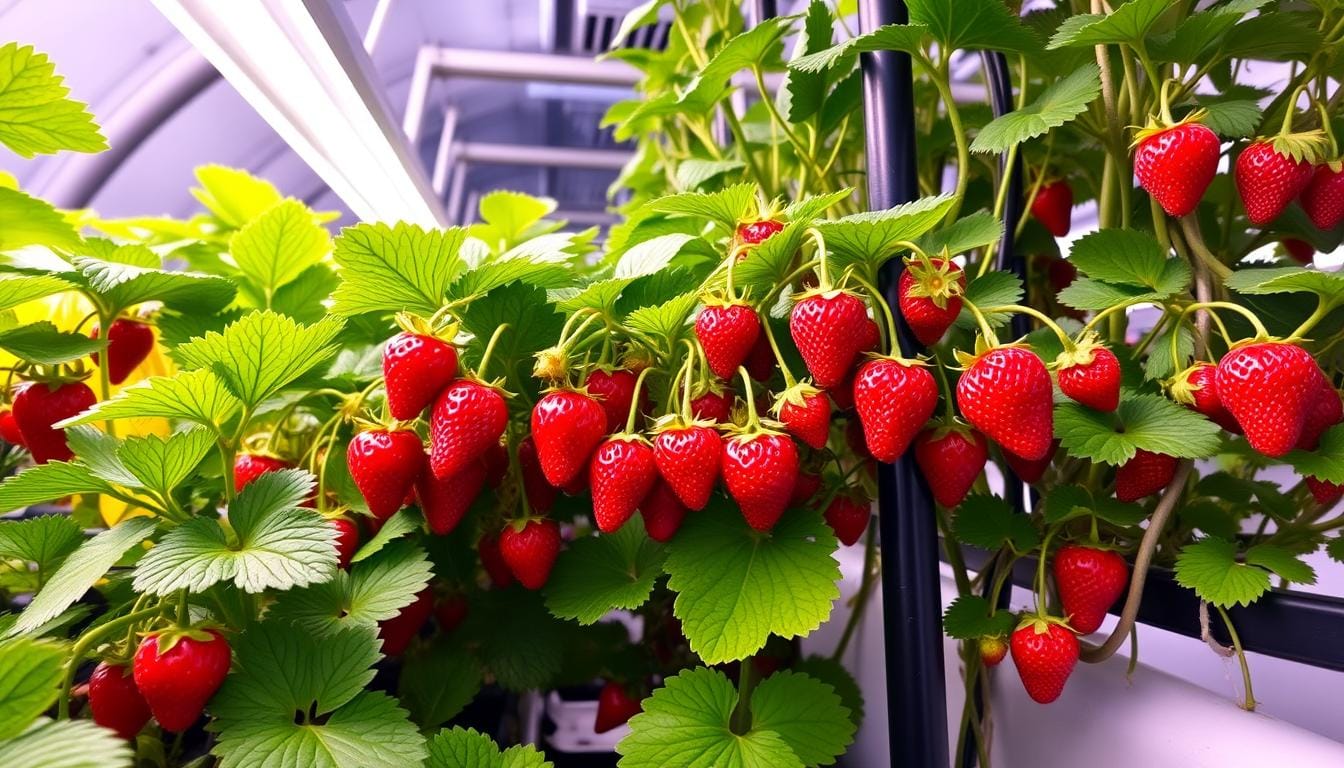Harvesting Hydroponic Strawberries: Maximize Your Yield with the right techniques to ensure your farm thrives. Starting a hydroponic strawberry farm can be exciting, especially with the promise of high yields and water efficiency. With proper strategies, you can achieve a bountiful harvest and make your venture successful.
To get the most from your farm, knowing what makes a harvest successful is key. By using the right strategies, you can increase your yield. These tips are for both new and experienced farmers to help you succeed in hydroponic strawberry farming.
Key Takeaways
- Understand the importance of maximizing hydroponic strawberry yield
- Learn the basics of hydroponic strawberry farming
- Discover the essential tips for harvesting hydroponic strawberries
- Optimize your hydroponic strawberry farm for the best results
- Implement strategies to maximize your hydroponic strawberry yield
- Enjoy a bountiful and rewarding hydroponic strawberry farming experience
Understanding Hydroponic Strawberry Growth Cycles
To boost strawberry yield, knowing the growth cycles of hydroponic strawberries is key. By understanding these cycles, you can follow the best practices for growing hydroponic strawberries. The growth cycle includes three main phases: vegetative growth, flowering, and fruit development.
The vegetative growth phase is when the plant grows its roots and leaves. This phase is vital for the plant’s health and productivity. By giving the plant the right conditions, like enough light, water, and nutrients, you help it grow strong. This sets the stage for a good harvest.
The flowering stage is next, where the plant makes flowers that will become strawberries. This stage is key for fruit production. By taking care of the plant during this time, like keeping the right temperature and humidity, you can help increase the yield.
The fruit development period is when the strawberries grow and get ripe. It’s important to keep the growing conditions right and watch the plants for any problems. By following these best practices, you can get a bigger harvest of delicious strawberries.
| Growth Phase | Description | Optimal Conditions |
|---|---|---|
| Vegatative Growth | Root and leaf development | Adequate light, water, and nutrients |
| Flowering Stage | Flower production | Optimal temperature and humidity |
| Fruit Development | Strawberry growth and ripening | Continued optimal growing conditions |
Essential Equipment for Successful Harvesting
To get the best strawberry growth optimization, you need the right tools. This includes a good hydroponic system, a reliable irrigation system, and a climate control system. With these, you can get a big harvest and increase your yield.
Some important equipment for a successful harvest includes:
- Hydroponic systems with precise nutrient control
- Irrigation systems with automated watering schedules
- Climate control systems with temperature and humidity management
Keeping your equipment in good shape is key. Regular checks help spot problems early. This way, you can fix them quickly and keep your strawberries growing well.
When picking out equipment for your hydroponic strawberry farm, look at this table. It compares different climate control systems:
| System Type | Temperature Range | Humidity Control |
|---|---|---|
| Basic Climate Control | 65-75°F | Manual adjustment |
| Advanced Climate Control | 60-80°F | Automated adjustment |
| Precision Climate Control | 55-85°F | Real-time monitoring and adjustment |
Identifying the Perfect Time to Harvest
Timing is key when harvesting high-yield hydroponic strawberries. You want to pick them when they’re at their best flavor and texture. To find the perfect time, look at their color, texture, and size.
Check for ripeness by looking at the color. Ripe strawberries are bright red, while unripe ones are green or white. Also, squeeze them gently. Ripe strawberries are firm but soft to the touch, unlike unripe ones which are hard.
Key Factors to Consider
- Color: Bright red for ripe strawberries, green or white for unripe ones
- Texture: Firm but yields to pressure for ripe strawberries, hard for unripe ones
- Size: Ripe strawberries are typically larger than unripe ones
By looking at these factors, you can pick your strawberries at the best time. This way, you’ll get a big and tasty harvest. Always handle your strawberries carefully to avoid damage. Also, store them right to keep them fresh and good.
With a bit of practice and patience, you’ll know when to harvest your strawberries. After putting in all the effort and dedication, you can finally relish the results of your labor.
How to Maximize Hydroponic Strawberry Yield Through Proper Technique
To get the most from your hydroponic strawberries, follow some key strawberry cultivation tips. Giving the right nutrients is critical. Strawberries need a mix of macronutrients and micronutrients to grow well.
Here are some important tips for a high yield:
- Prune and train plants for better growth and more fruit
- Ensure they get enough light for photosynthesis and growth
- Keep the temperature right to prevent disease and promote health
By using these strawberry cultivation tips, you can make your hydroponic strawberry farm thrive. Keep an eye on your plants and tweak your methods as needed for a great harvest.
With the right approach and care, you can have a successful hydroponic strawberry crop. These strategies will help you increase your yield and enjoy fresh, tasty strawberries.
| Factor | Importance | Tips |
|---|---|---|
| Pruning | High | Prune plants regularly to promote healthy growth |
| Lighting | Medium | Provide 12-14 hours of light per day |
| Temperature | High | Maintain temperatures between 65-75°F |
Maintaining Optimal Growing Conditions
To grow hydroponic strawberries well, you need to keep the growing conditions just right. This means controlling things like temperature, humidity, light, and nutrients. By doing this, you help your plants grow strong and healthy, leading to a bigger harvest.
Temperature is key for growing strawberries. They do best in temperatures between 65-75°F (18-24°C). Keeping humidity between 40-60% helps prevent diseases. Strawberries also need lots of light to grow fruit well.
Key Factors for Optimal Growth
- Temperature: 65-75°F (18-24°C)
- Humidity: 40-60%
- Light: High intensity, with a minimum of 12 hours of light per day
- Nutrient balance: A balanced nutrient solution that provides essential nutrients for plant growth
By managing these factors, you can make a perfect home for your hydroponic strawberries. Keeping the growing conditions right is key to a successful harvest. With the right care, your plants will grow well, and you’ll get a lot of fruit.
Preventing Common Harvest-Time Problems
To get a big crop and boosting strawberry harvest yield, you must avoid common problems. Over-ripening is a big issue that can lower your yield. It’s key to pick strawberries when they’re just right.
Fungal diseases can also hurt your strawberry harvest yield. Keep your plants healthy by growing them right and ensuring good air flow. Pests like aphids and whiteflies can be a problem too. But, you can fight them with smart pest control.

Knowing about these issues and how to stop them can help you boost your strawberry harvest yield. This way, you can have a great crop.
Post-Harvest Handling and Storage
To get the most from your hydroponic strawberries, it’s key to handle and store them right after picking. First, clean the strawberries to get rid of dirt or debris. This step is important to keep the fruit fresh and prevent spoilage.
For storing, keep the strawberries in a cool spot between 32-40°F (0-4°C). This temperature slows down ripening, letting you enjoy them for longer. Here are some tips for storing your strawberries:
- Store strawberries in a cool, dry place
- Avoid exposing strawberries to direct sunlight
- To prevent strawberries from picking up unwanted odors, store them separately from foods with strong smells.
Choosing the right packaging is also important. Use containers or bags that let air in but keep moisture out. By following these steps, you can keep your strawberries fresh and enjoy them for a longer time.
In hydroponic strawberry farming, paying attention to every detail is essential for a good harvest. By taking care of your strawberries after picking, you can keep them fresh and healthy. This way, you can enjoy the fruits of your labor for a longer time.
| Storage Temperature | Storage Duration |
|---|---|
| 32-40°F (0-4°C) | 7-10 days |
| 40-50°F (4-10°C) | 5-7 days |
Advanced Strategies for Yield Enhancement
To boost strawberry yield, advanced strategies are key. These help plants grow well and produce more fruit. Pruning is important to shape the plant and encourage more fruiting.
Pollination is also critical for strawberries to grow fruit. You can use pollinators or vibrators to help. Plant spacing is also important. It affects yield and fruit quality. Sufficient space improves air, reduces disease, and boosts light and nutrient access.
Some top tips for growing hydroponic strawberries include:
- Keep an eye on the nutrient solution balance
- Ensure the right temperature and humidity
- Provide enough light and space between plants

By using these strategies and following best practices, you can increase strawberry yield. Always check and tweak your methods for the best results.
| Strategy | Benefits |
|---|---|
| Pruning techniques | Promotes healthy growth, encourages fruiting |
| Pollination management | Enhances fruit production, improves yield |
| Plant spacing optimization | Improves air circulation, reduces disease risk, increases access to light and nutrients |
Monitoring and Recording Your Harvest Data
To improve strawberry growth optimization, it’s key to track your harvest data. You should watch things like temperature, humidity, and nutrient levels. This helps you spot trends and make better choices for your farm.
Some important things to keep an eye on include:
- Temperature changes
- Humidity levels
- Nutrient levels in the soil
- Plant growth and development
- Yield and how often you harvest
By tracking and analyzing this data, you can find ways to get better. For instance, you might see that plants do best in certain temperatures or with specific nutrients. Making choices based on data can help you grow more strawberries.
Using tools like spreadsheets or software can help you manage your data. Visual tools like charts and graphs can also show trends. By focusing on data, you can make your strawberry farm more successful.
Remember, keeping an eye on your data is a continuous task. Regularly check and update your records to make the best choices for your farm. With the right data, you can make your farm thrive and enjoy a big harvest.
| Factor | Optimal Range | Impact on Yield |
|---|---|---|
| Temperature | 65-75°F (18-24°C) | Increased yield and plant growth |
| Humidity | 40-60% | Improved plant health and reduced disease |
| Nutrient levels | Balanced blend of NPK | Optimized plant growth and development |
Sustainable Practices in Hydroponic Strawberry Production
When growing high-yield hydroponic strawberries, think about the environment. Using sustainable methods helps reduce your impact. This way, you support a greener future for hydroponic farming.
Water Conservation Methods
Water is key in growing hydroponic strawberries. Use drip irrigation and collect rainwater to save water. These steps help you grow more strawberries with less harm to the environment.
Energy Efficiency Tips
Lower your energy use with LED grow lights and better climate control. These tips cut costs and support eco-friendly strawberry farming.
Waste Reduction Strategies
Composting and recycling cut down on waste. These steps help you grow strawberries sustainably. They also reduce your environmental footprint.
Adding these green practices to your farm makes it more eco-friendly. Always keep up with new strawberry growing tips. This way, you’ll grow more and harm less.
Conclusion: Implementing Your Hydroponic Strawberry Success Plan
Starting your hydroponic strawberry farm is exciting. Success comes from careful planning, hard work, and caring for the environment. Follow the steps in this guide to grow more strawberries and get better harvests.
Keep track of your strawberry harvests to see what works best. Learn about new hydroponic tech and farming methods. This will help you stay ahead. Also, focus on green farming to save resources and reduce waste.
You’re ready to grow a successful hydroponic strawberry farm. Enjoy the journey, celebrate your wins, and explore new ways to grow sustainably.

